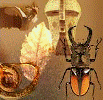Museum, University of Nebraska State
Date of this Version
2001
Abstract
For those of us whose noses know (and don't like) pollen, late October is a time for celebration in Nebraska because it is the end of the hay fever season. When one's nose is a sensitive bio-detector of the presence of pollen, one's brain usually appreciates putting a name to whatever is causing the itchy eyes and runny nose. The job of putting names on the types of pollen in the air has been done by a dedicated team of pollen counters in the Division of Botany, University of Nebraska State Museum. This group, led by Curator Peg Bolick, has been catching, counting, and identifying these allergens since 1990. They do this five days a week from late February through mid-October each year.
Problem pollen almost always comes from plants that use wind to transport their pollen to another plant. The chance of an individual grain finding the flower of another plant of the same species is much smaller with wind pollination than it is with animal pollination. Wind-pollinated plants compensate for the lack of precision by producing millions of extra pollen grains, some of which land in noses. Pollen from animal-pollinated plants is sticky, usually forming clumps that are too large to remain in the air very long. However, Nebraska's strong winds occasionally strip these sticky grains from flowers and carry them to noses or pollen samplers. Air-borne pollen has a more restricted size range than that carried by animals. Pollen grains are measured in microns, a unit that is one millionth of a meter. The largest pollen grains, produced by plants that use animals for pollination, are barely visible to the naked eye at about 250 microns (one fourth of a millimeter). The size range for pollen that is transported by wind is an order of magnitude smaller. Unless it has air bladders like pine pollen, grains that are much larger than 100 microns (the size of corn pollen) usually fall out of the air before traveling more than a few meters. At the other end of the scale, a pollen grain smaller than ten microns (the size of ragweed pollen) cannot be caught efficiently by plant stigmas, the part of the flower that leads to the ovule for fertilization.



Comments
Published in Museum Notes (November 2001) No. 110: 6 p.